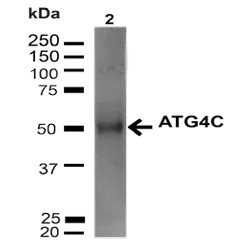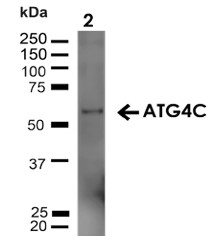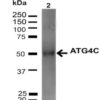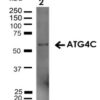Anti-Atg4C Antibody (23002)
$466.00
SKU: 23002
Categories: Antibody Products, Autophagy Antibodies, Products
Overview
Product Name Anti-Atg4C Antibody (23002)
Description Anti-Atg4C Rabbit Polyclonal Antibody
Target Atg4C
Species Reactivity Human, Rat
Applications WB,ICC/IF
Host Rabbit
Clonality Polyclonal
Immunogen Synthetic peptide corresponding to amino acids at the N-terminus of human Atg4C.
Properties
Form Liquid
Concentration 1.0 mg/mL
Formulation PBS, pH 7.4, 50% glycerol, 0.09% sodium azide.Concentration: 1mg/ml
Buffer Formulation Phosphate Buffered Saline
Buffer pH pH 7.4
Buffer Anti-Microbial 0.09% Sodium Azide
Buffer Cryopreservative 50% Glycerol
Format Purified
Purification Purified by peptide immuno-affinity chromatography
Specificity Information
Specificity This antibody recognizes human and rat Atg4C.
Target Name Cysteine protease ATG4C
Target ID Atg4C
Uniprot ID Q96DT6
Alternative Names EC 3.4.22.-, AUT-like 3 cysteine endopeptidase, Autophagy-related cysteine endopeptidase 3, Autophagin-3, Autophagy-related protein 4 homolog C, HsAPG4C
Gene Name ATG4C
Sequence Location Cytoplasm
Biological Function Cysteine protease that plays a key role in autophagy by mediating both proteolytic activation and delipidation of ATG8 family proteins (PubMed:21177865, PubMed:29458288, PubMed:30661429). The protease activity is required for proteolytic activation of ATG8 family proteins: cleaves the C-terminal amino acid of ATG8 proteins MAP1LC3 and GABARAPL2, to reveal a C-terminal glycine (PubMed:21177865). Exposure of the glycine at the C-terminus is essential for ATG8 proteins conjugation to phosphatidylethanolamine (PE) and insertion to membranes, which is necessary for autophagy (By similarity). In addition to the protease activity, also mediates delipidation of ATG8 family proteins (PubMed:29458288, PubMed:33909989). Catalyzes delipidation of PE-conjugated forms of ATG8 proteins during macroautophagy (PubMed:29458288, PubMed:33909989). Compared to ATG4B, the major protein for proteolytic activation of ATG8 proteins, shows weaker ability to cleave the C-terminal amino acid of ATG8 proteins, while it displays stronger delipidation activity (PubMed:29458288). In contrast to other members of the family, weakly or not involved in phagophore growth during mitophagy (PubMed:33773106). {UniProtKB:Q9Y4P1, PubMed:21177865, PubMed:29458288, PubMed:30661429, PubMed:33773106, PubMed:33909989}.
Research Areas Autophagy
Background Autophagy is a catabolic process that results in the degradation of bulk cytoplasmic contents within autophagosomes and lysosomes. Atg4C is a homolog of yeast Apg4, a cysteine protease involved in autophagy. The deduced 458-amino acid protein contains a putative active-site cysteine at position 110. Atg4C shares significant similarity with yeast Apg4, except for divergence at its N- and C-terminal ends. The absence of an N-terminal signal sequence suggests that Atg4C is a cytoplasmic enzyme. Northern blot analysis detected a 3.5-kb transcript in many tissues, with highest expression in skeletal muscle, heart, liver, and testis. It was also detected in some tumor cell lines, but not in fetal tissues.
Application Images



Description Immunoblotting: use at 1-2ug/ml. A band of ~52kDa is detected. Detection of Atg4C in 20ug of 293T cell lysate.

Description Immunoblotting: use at 1-2ug/ml. A band of ~52kDa is detected. Detection of Atg4C in 20ug of 293T cell lysate.
Handling
Storage This antibody is stable for at least one (1) year at -20°C.
Dilution Instructions Dilute in PBS or medium that is identical to that used in the assay system.
Application Instructions Immunoblotting: use at 1-2ug/mL. A band of ~52kDa is detected.
These are recommended concentrations.
Endusers should determine optimal concentrations for their applications.
These are recommended concentrations.
Endusers should determine optimal concentrations for their applications.
References & Data Sheet
Data Sheet  Download PDF Data Sheet
Download PDF Data Sheet
 Download PDF Data Sheet
Download PDF Data Sheet





